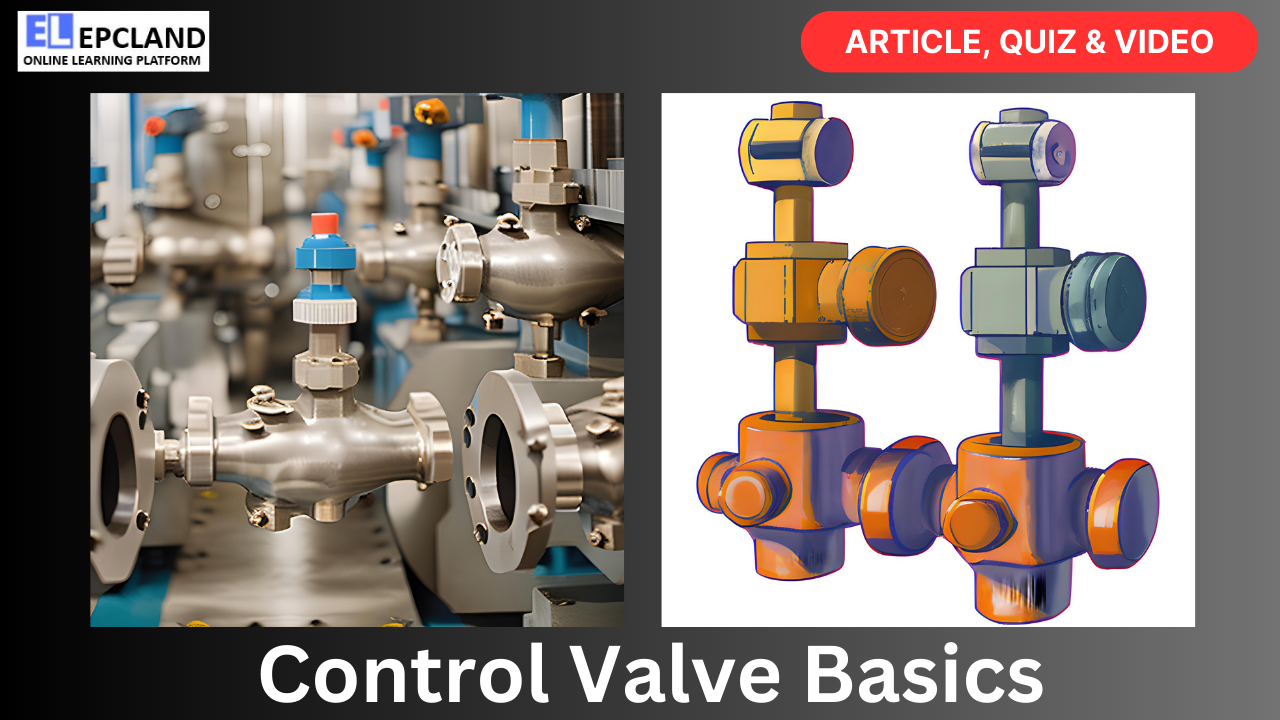Introduction
The Oil & Gas Industry is a global powerhouse that drives the world’s energy needs. Within this industry, control valves play a crucial role in ensuring the safe and efficient operation of various processes. These valves are not mere mechanical components; they are the silent heroes that regulate the flow, pressure, and temperature of fluids in pipelines and systems. In this article, we will delve into the fundamentals of control valves used in Oil & Gas Industry projects, exploring their types, components, working principle, sizing, installation, maintenance, safety considerations, and real-world applications.
Table of Contents
Do not miss the Complete Course on Piping Engineering
By EPCLand
Understanding Control Valves
Definition and Types
Control valves are devices designed to control the flow of fluids, such as crude oil, natural gas, or petrochemicals, in pipelines and processing systems. They come in several types, each suited for specific applications:
- Globe Valves: These are commonly used for throttling or regulating flow. Their design consists of a spherical body and a movable plug or disc that controls the flow by moving up and down.
- Butterfly Valves: These valves use a circular disc mounted on a spindle to control flow. They are often used for large-diameter applications where quick shutoff is necessary.
- Ball Valves: Ball valves employ a spherical closure unit to control flow. They are known for their rapid on/off operation and tight sealing, making them suitable for many Oil & Gas applications.
- Plug Valves: Plug valves use a cylindrical or conical plug to control flow. They are often used in applications where a high-pressure drop needs to be maintained.
Key Functions in Oil & Gas Projects
Control valves perform essential functions in Oil & Gas projects, including:
- Flow Control: Regulating the rate of fluid flow to maintain desired process conditions.
- Pressure Regulation: Adjusting pressure levels to ensure safe and efficient operation.
- Temperature Control: Modulating the temperature of fluids to prevent overheating or freezing.
Components of Control Valves
To understand control valves better, it’s crucial to explore their key components:
Actuators
Actuators are the muscle behind control valves, responsible for opening and closing them according to the input signal. Common types of actuators include:
- Pneumatic Actuators: These use compressed air to move the valve’s stem and control flow. They are known for their fast response times.
- Electric Actuators: Electric actuators rely on electricity to move the valve’s stem. They are often used when precise control is required.
- Hydraulic Actuators: Hydraulic actuators use hydraulic fluid to operate the valve. They are suitable for applications requiring high force and precision.
Valve Body
The valve body is the outer shell of the control valve, and its design plays a critical role in the valve’s performance. Factors to consider include the materials used and the valve’s size and design.
Trim and Internals
Inside the valve body, the trim and internals are responsible for controlling the flow of fluids. Key components include:
- Discs: These are movable elements that control the flow by varying their position within the valve.
- Seats: Seats provide a sealing surface for the disc to prevent leakage.
- Stems: Stems connect the actuator to the disc, transmitting the motion from the actuator to the valve.
- Flow Paths: The internal design of the valve body, including passages and chambers, determines how the fluid flows through the valve.
Working Principle of Control Valves
The working principle of control valves is based on the modulation of flow through the valve to achieve the desired process conditions. This modulation is achieved by varying the position of the valve’s internal components, primarily the disc and seat. Here’s how it works:
- Flow Modulation: Control valves control the flow rate of fluids by changing the effective flow area. When the valve is fully open, it allows maximum flow, and as it closes, the flow area decreases, reducing the flow rate.
- Pressure Regulation: By adjusting the position of the valve’s disc, control valves can regulate the pressure in the system. When the disc partially closes, it restricts the flow, increasing pressure upstream of the valve.
- Temperature Control: Control valves can also modulate the flow of heat transfer fluids to control temperature. By regulating the flow of hot or cold fluids, they maintain the desired process temperature.
Control Valve Sizing and Selection
Selecting the right control valve for a specific application is a critical task. Several factors influence control valve selection:
Factors Influencing Selection
- Fluid Type: The type of fluid being controlled (e.g., gas, liquid, corrosive chemicals) influences the choice of materials and valve type.
- Flow Rate: The required flow rate dictates the valve size.
- Pressure Drop: The desired pressure drop across the valve affects the valve’s design.
Sizing Methods
Sizing control valves involves determining the required valve size to achieve the desired control. Common sizing methods include:
- Equal Percentage Sizing: This method is used when the relationship between valve position and flow rate should be exponential. It is often used for applications requiring precise control.
- Linear Sizing: Linear sizing provides a constant relationship between valve position and flow rate. It is suitable for applications where linear control is essential.
Considerations for Different Control Applications
The choice of control valve also depends on the specific control application:
- Flow Control: In flow control applications, maintaining a constant flow rate is crucial. Control valves with good turndown ratios and linear characteristics are often preferred.
- Pressure Control: Pressure control valves are designed to maintain a constant pressure in the system. They should be able to handle variations in flow.
- Temperature Control: Temperature control valves modulate the flow of heat transfer fluids to control temperature. They require precise control to prevent overheating or freezing.
Installation and Maintenance
Proper installation and regular maintenance are essential for the reliable operation of control valves:
Installation Practices
- Alignment: Ensure proper alignment of the valve and actuator to prevent excessive wear and damage.
- Instrumentation: Install appropriate instrumentation, such as positioners and controllers, to enhance valve performance.
- Piping: Properly size and configure the piping around the valve to minimize pressure drop and turbulence.
Regular Maintenance and Inspection
- Routine Inspection: Regularly inspect valves for signs of wear, leakage, or corrosion.
- Calibration: Calibrate the valve and its instrumentation to ensure accurate control.
- Lubrication: Maintain proper lubrication of moving parts to prevent friction and wear.
Do not miss the Complete Course on Piping Engineering
By EPCLand
Common Issues and Troubleshooting
Understanding common control valve issues is crucial for troubleshooting and maintaining optimal performance:
- Leakage: Valve leakage can lead to product loss and safety hazards. It may be caused by worn seals or improper seating.
- Sticking: Sticking valves can result from debris or corrosion in the trim. Regular cleaning and maintenance can prevent this issue.
- Cavitation: Cavitation occurs when there is a rapid change in pressure, leading to the formation and collapse of vapor bubbles. This can damage valve components and should be avoided.
Control Valve Accessories
Control valves are often accompanied by accessories that enhance their performance and functionality:
Positioners
Positioners are devices that precisely position the valve according to the control signal. They ensure accurate control and reduce overshoot.
I/P Converters
I/P converters, or current-to-pressure converters, convert electrical signals into pneumatic signals for pneumatic actuators.
Valve Controllers
Valve controllers receive and process control signals, providing the intelligence needed to regulate valve position.
Fail-Safe Mechanisms
Fail-safe mechanisms are essential for safety-critical applications. They ensure that the valve returns to a safe position in case of a power failure or other emergency.
Safety Considerations
Safety is paramount in the Oil & Gas Industry, and control valves play a crucial role in ensuring it:
Importance of Safety
- Process Safety: Control valves help maintain safe operating conditions, preventing accidents and incidents.
- Environmental Protection: Properly functioning valves prevent spills and emissions that can harm the environment.
- Asset Protection: Control valves protect valuable equipment from damage due to overpressure or excessive flow.
Safety Features in Control Valves
- Emergency Shutdown: Many control valves have emergency shutdown (ESD) features that allow them to quickly close in case of a safety breach.
- Pressure Relief: Pressure relief valves are often integrated with control systems to prevent overpressure.
- Safety Instrumented Systems (SIS): Control valves can be part of SIS, which act to prevent hazardous events.
Compliance with Standards and Regulations
Control valves must adhere to industry standards and regulations, such as API, ASME, and ISA, to ensure safety and reliability.
Case Studies
Let’s explore some real-world examples of control valve applications in Oil & Gas projects:
Case Study 1: Flow Control in Refinery
In a petroleum refinery, control valves are used to regulate the flow of various products through distillation columns. Precise control is essential to achieve the desired product quality and yield.
Case Study 2: Pressure Control in Natural Gas Pipeline
In a natural gas pipeline, control valves maintain the pressure within safe limits. They ensure that gas flows smoothly from production facilities to distribution networks without causing pressure fluctuations.
Case Study 3: Temperature Control in Petrochemical Plant
In a petrochemical plant, control valves are crucial for maintaining the temperature of reaction vessels. Accurate temperature control is vital to optimize chemical reactions and ensure product quality.
Advantages and Disadvantages of Control Valves
Advantages
| Advantages of Control Valves |
|---|
| 1. Precise control of fluid parameters such as flow, pressure, and temperature. |
| 2. Versatility in handling a wide range of fluids, from gases to liquids and corrosive chemicals. |
| 3. Rapid response times for maintaining process stability. |
| 4. Integration with automation and control systems for enhanced efficiency. |
| 5. Enhanced safety through features like emergency shutdown and pressure relief. |
Disadvantages
| Disadvantages of Control Valves |
|---|
| 1. Initial investment and installation costs can be high. |
| 2. Maintenance and calibration requirements to ensure consistent performance. |
| 3. Possibility of leakage if not properly maintained. |
| 4. Limited turndown ratio in some valve types, affecting their control range. |
| 5. Potential for cavitation and erosion in high-pressure drop applications. |
Do not miss the Complete Course on Piping Engineering
By EPCLand
Conclusion
Control valves are the unsung heroes of the Oil & Gas Industry, silently working to ensure the safe and efficient operation of processes. Their diverse types, components, sizing methods, and accessories make them versatile tools in a wide range of applications. Proper installation, maintenance, and safety considerations are paramount in maximizing their performance and protecting assets.
As the Oil & Gas Industry continues to evolve, control valves will play an increasingly vital role in meeting energy demands while adhering to stringent safety and environmental standards. They are the gatekeepers of the industry, ensuring that the world’s energy flows reliably and responsibly.
In the quest for innovation and efficiency, the basics of control valves will remain a cornerstone of Oil & Gas projects, guaranteeing that the industry continues to thrive.
FAQs
1. What is the primary purpose of control valves in the Oil & Gas Industry?
Control valves in the Oil & Gas Industry primarily serve to regulate the flow, pressure, and temperature of fluids in pipelines and processing systems. They help maintain safe and efficient operations by controlling these essential parameters.
2. How do control valves work to control fluid flow?
Control valves work by modulating the flow area through which fluid passes. When the valve is fully open, it allows maximum flow, and as it closes, the flow area decreases, reducing the flow rate. This modulation is achieved by varying the position of the valve’s internal components, such as the disc and seat.
3. What are the key considerations when selecting a control valve for a specific application?
When selecting a control valve, key considerations include the type of fluid being controlled, the required flow rate, and the desired pressure drop across the valve. Additionally, the specific control application (flow, pressure, temperature) will influence the choice of valve type and characteristics.
4. What are some common maintenance issues with control valves?
Common maintenance issues with control valves include leakage, sticking of valve components due to debris or corrosion, and cavitation, which occurs when there’s a rapid change in pressure, leading to the formation and collapse of vapor bubbles. Routine inspection, calibration, and proper lubrication can help prevent these issues.
5. How do control valves contribute to safety in the Oil & Gas Industry?
Control valves play a crucial role in safety by helping maintain safe operating conditions. They can quickly close during emergencies (emergency shutdown or ESD) to prevent accidents, regulate pressure to safe levels, and be integrated into safety instrumented systems (SIS) to prevent hazardous events. This enhances overall safety in the industry.
Recommended courses (Published on EPCLand)
- Basics of Piping Engineering
- Piping Layout Engineering
- Piping Material Engineering
- Piping Stress Analysis
- Complete Course on Piping Engineering
- Material Requisitions
- Piping Material Specifications
- Valve Material Specifications
Don’t miss the published articles on following:
| Industrial Applications with Link | Industrial Applications with Link |
| Corrosion Monitoring Instruments | Safety Instrumented Systems |
| Instrumentation in Renewable Energy | Safety Relief Valves |
| Orifice Plate in the Oil & Gas Industry | Well Test Instruments |
| Wellhead Pressure and Temperature Gauges | Wireless Instrumentation in Oil & Gas Projects |
Do not miss the Complete Course on Piping Engineering
By EPCLand
Related Video
Attempt Quiz
Question 1:
What is the primary function of a control valve in an oil & gas project?
Explanation: The primary function of a control valve in an oil & gas project is to control the flow of fluids, such as oil and gas, within the system.
Question 2:
What is the significance of the control valve’s position in regulating fluid flow?
Explanation: The position of the control valve is significant as it directly controls the flow rate and pressure of fluids in the system.
Question 3:
Which type of control valve is commonly used for precise control in oil & gas projects?
Explanation: Globe valves are commonly used for precise control in oil & gas projects due to their ability to regulate flow accurately.
Question 4:
What is cavitation in the context of control valves, and why is it a concern in oil & gas projects?
Explanation: Cavitation is a concern in oil & gas projects because it refers to a condition where vapor bubbles form and collapse, potentially causing damage to control valves and other equipment.
Question 5:
What is the purpose of the actuator in a control valve?
Explanation: The actuator in a control valve is responsible for controlling the valve’s position to regulate fluid flow in the system.



